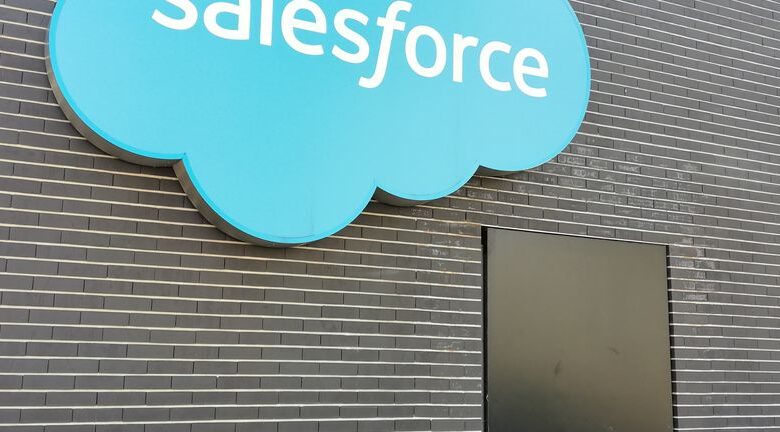Is Salesforce, Inc. (NYSE:CRM) Trading At A 28% Discount?

Key Insights
-
The projected fair value for Salesforce is US$399 based on 2 Stage Free Cash Flow to Equity
-
Salesforce is estimated to be 28% undervalued based on current share price of US$287
-
Analyst price target for CRM is US$336 which is 16% below our fair value estimate
How far off is Salesforce, Inc. (NYSE:CRM) from its intrinsic value? Using the most recent financial data, we’ll take a look at whether the stock is fairly priced by taking the expected future cash flows and discounting them to their present value. We will take advantage of the Discounted Cash Flow (DCF) model for this purpose. There’s really not all that much to it, even though it might appear quite complex.
We would caution that there are many ways of valuing a company and, like the DCF, each technique has advantages and disadvantages in certain scenarios. For those who are keen learners of equity analysis, the Simply Wall St analysis model here may be something of interest to you.
Check out our latest analysis for Salesforce
The Method
We are going to use a two-stage DCF model, which, as the name states, takes into account two stages of growth. The first stage is generally a higher growth period which levels off heading towards the terminal value, captured in the second ‘steady growth’ period. To start off with, we need to estimate the next ten years of cash flows. Where possible we use analyst estimates, but when these aren’t available we extrapolate the previous free cash flow (FCF) from the last estimate or reported value. We assume companies with shrinking free cash flow will slow their rate of shrinkage, and that companies with growing free cash flow will see their growth rate slow, over this period. We do this to reflect that growth tends to slow more in the early years than it does in later years.
Generally we assume that a dollar today is more valuable than a dollar in the future, so we discount the value of these future cash flows to their estimated value in today’s dollars:
10-year free cash flow (FCF) forecast
|
2024 |
2025 |
2026 |
2027 |
2028 |
2029 |
2030 |
2031 |
2032 |
2033 |
|
|
Levered FCF ($, Millions) |
US$8.52b |
US$11.7b |
US$13.3b |
US$14.8b |
US$16.9b |
US$19.2b |
US$20.9b |
US$22.3b |
US$23.5b |
US$24.6b |
|
Growth Rate Estimate Source |
Analyst x26 |
Analyst x27 |
Analyst x28 |
Analyst x11 |
Analyst x6 |
Analyst x6 |
Est @ 8.77% |
Est @ 6.86% |
Est @ 5.51% |
Est @ 4.57% |
|
Present Value ($, Millions) Discounted @ 7.1% |
US$8.0k |
US$10.2k |
US$10.8k |
US$11.3k |
US$12.0k |
US$12.7k |
US$12.9k |
US$12.9k |
US$12.7k |
US$12.4k |
(“Est” = FCF growth rate estimated by Simply Wall St)
Present Value of 10-year Cash Flow (PVCF) = US$116b
We now need to calculate the Terminal Value, which accounts for all the future cash flows after this ten year period. For a number of reasons a very conservative growth rate is used that cannot exceed that of a country’s GDP growth. In this case we have used the 5-year average of the 10-year government bond yield (2.4%) to estimate future growth. In the same way as with the 10-year ‘growth’ period, we discount future cash flows to today’s value, using a cost of equity of 7.1%.
Terminal Value (TV)= FCF2033 × (1 + g) ÷ (r – g) = US$25b× (1 + 2.4%) ÷ (7.1%– 2.4%) = US$537b
Present Value of Terminal Value (PVTV)= TV / (1 + r)10= US$537b÷ ( 1 + 7.1%)10= US$271b
The total value is the sum of cash flows for the next ten years plus the discounted terminal value, which results in the Total Equity Value, which in this case is US$387b. To get the intrinsic value per share, we divide this by the total number of shares outstanding. Relative to the current share price of US$287, the company appears a touch undervalued at a 28% discount to where the stock price trades currently. Remember though, that this is just an approximate valuation, and like any complex formula – garbage in, garbage out.
The Assumptions
Now the most important inputs to a discounted cash flow are the discount rate, and of course, the actual cash flows. If you don’t agree with these result, have a go at the calculation yourself and play with the assumptions. The DCF also does not consider the possible cyclicality of an industry, or a company’s future capital requirements, so it does not give a full picture of a company’s potential performance. Given that we are looking at Salesforce as potential shareholders, the cost of equity is used as the discount rate, rather than the cost of capital (or weighted average cost of capital, WACC) which accounts for debt. In this calculation we’ve used 7.1%, which is based on a levered beta of 1.020. Beta is a measure of a stock’s volatility, compared to the market as a whole. We get our beta from the industry average beta of globally comparable companies, with an imposed limit between 0.8 and 2.0, which is a reasonable range for a stable business.
SWOT Analysis for Salesforce
Strength
Weakness
Opportunity
Threat
Moving On:
Valuation is only one side of the coin in terms of building your investment thesis, and it ideally won’t be the sole piece of analysis you scrutinize for a company. It’s not possible to obtain a foolproof valuation with a DCF model. Rather it should be seen as a guide to “what assumptions need to be true for this stock to be under/overvalued?” If a company grows at a different rate, or if its cost of equity or risk free rate changes sharply, the output can look very different. Can we work out why the company is trading at a discount to intrinsic value? For Salesforce, we’ve put together three pertinent elements you should consider:
-
Risks: Every company has them, and we’ve spotted 2 warning signs for Salesforce you should know about.
-
Future Earnings: How does CRM’s growth rate compare to its peers and the wider market? Dig deeper into the analyst consensus number for the upcoming years by interacting with our free analyst growth expectation chart.
-
Other High Quality Alternatives: Do you like a good all-rounder? Explore our interactive list of high quality stocks to get an idea of what else is out there you may be missing!
PS. Simply Wall St updates its DCF calculation for every American stock every day, so if you want to find the intrinsic value of any other stock just search here.
Have feedback on this article? Concerned about the content? Get in touch with us directly. Alternatively, email editorial-team (at) simplywallst.com.
This article by Simply Wall St is general in nature. We provide commentary based on historical data and analyst forecasts only using an unbiased methodology and our articles are not intended to be financial advice. It does not constitute a recommendation to buy or sell any stock, and does not take account of your objectives, or your financial situation. We aim to bring you long-term focused analysis driven by fundamental data. Note that our analysis may not factor in the latest price-sensitive company announcements or qualitative material. Simply Wall St has no position in any stocks mentioned.




